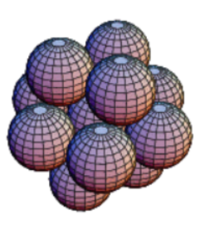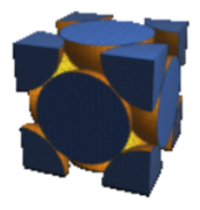Kepler's Conjecture Intuition
Author: Eli LeChien
The Main Course
The same method applied in the last section could be extended to the three dimensional case with spheres. Figure 1 shows the face-centered cubic arrangement of spheres, which is quite analogous to the two dimensional arrangement in Figure 1.
Figure 1: Face Centered Cubic Arrangement (Weisstein)
If one were to repeat this structure, it could be imagined how the spheres could be sliced in a way that forms a representative unit. The simplest unit for this is shown in Figure 2. This is a cube, which is composed of six hemispheres (one for each face) and eight eighths of a sphere (one for each corner). This means that the unit contains a total of four full spheres. Looking at the figure, the surrounding cube has a diagonal equal to the length of four sphere radii. From this information, the packing density of spheres can be derived.
Figure 2: Representative Sphere Packing Unit (Weisstein)
The volume of a cube with side s is known to be:
$ V_{cube\ }=s^{3} $
Because the diagonal d is a factor of 2 larger than a given side, the volume becomes:
$ V_{cube\ }=\left(\frac{d}{\sqrt{2}}\right)^{3}=\ \frac{d^{3}}{2\sqrt{2}} $
The volume of a four spheres with radius r is:
$ V_{spheres}\ =4\cdot\frac{4}{3}\pi r^{3}=\frac{16}{3}\pi r^{3} $
Knowing that the diameter is 4 radii, divide the volume of the cube by the volume of the spheres. The packing density $ \eta_{spheres} $ is:
$ \eta_{spheres}\ =\ \frac{V_{spheres}}{V_{cube}} $
$ \eta_{spheres}\ =\ \frac{\frac{16}{3}\pi r^{3}}{\frac{d^{3}}{2\sqrt{2}}}=\frac{\frac{16}{3}\pi r^{3}}{\frac{\left(4r\right)^{3}}{2\sqrt{2}}} $
$ \eta_{spheres}=\frac{\pi}{3\sqrt{2}}\approx74.05\% $
Again, this is not a rigorous proof that this is the densest packing of spheres. However, it does make some intuitive sense that this would at least be close to the actual value. Could it be proved that this is the absolute best packing, or is there a viable counterexample? If there was a reasonably sized proof that would be satisfying, it would be given here. That’s not the case.
In 1998, Thomas Hales was able to prove the Kepler Conjecture. It is not the kind of proof that most are used to, as it extensively used computers to check scenarios— a proof by exhaustion. This paper was 250 pages long, as as a result it took mathematicians four years to work through it and check the logic. Still, with the magnitude of information there was not absolute confidence in the proof. Hales worked extensively to translate his proof to use “formal logic.” In 2017, the Kepler Conjecture was finally accepted as a mathematical truth through the work of Hales (Lewis).



